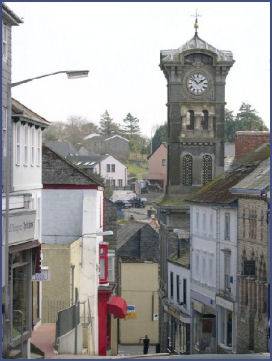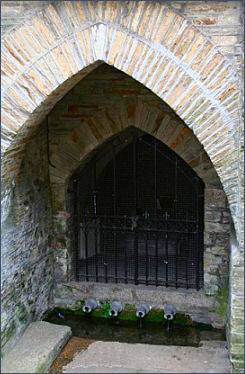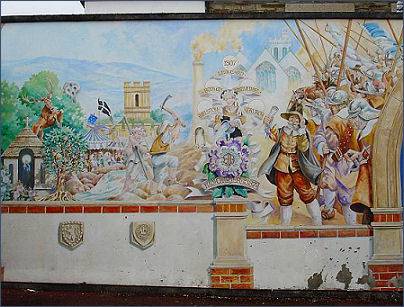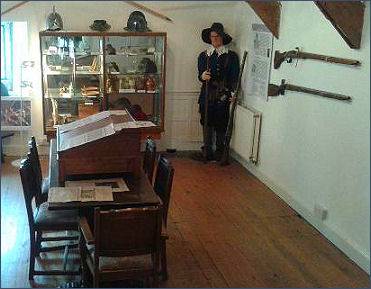Liskeard
OS Grid ref:- SX249641
 The lively market town of Liskeard is situated at the head of the Looe Valley and near to the popular resorts of Looe and Polperro.
The lively market town of Liskeard is situated at the head of the Looe Valley and near to the popular resorts of Looe and Polperro.
Known in Cornish as Lyskerry, 'lys', means court or seat of Justice, and 'Kerryt', means a local chief or king, Liskeard was originally known as Liscarret and is recorded in the Domesday Book as one of the holdings of Robert, Count of Mortain, the half-brother of William the Conqueror. The town was granted its charter in 1240 by Richard, Earl of Cornwall, the brother of King Henry III and was once an important tin mining town which still has much to offer the visitor.
The Church of St. Martin, founded in the thirteenth century, is the second largest church in Cornwall. Much of the present church dates to the fifteenth century while the tower was built in 1902. Some fine late nineteenth and early twentieth century stained glass windows were inserted and choir stalls and screens with some impressive carving were also erected in the early twentieth century.
The town boasts some superb Georgian buildings, while the Victorian Town Hall has a strong Italianate influence. There are some imposing stone buildings in the Parade, and a Regency Market Hall.Leisure facilities are available at Lux Park, including an indoor sports and fitness centre as well as an all-weather floodlit football and hockey pitch.
 The Pipe Well (right) is worthy of a visit, the well is referred to in fourteenth century documents as "The Well of Lyskiret " or "The Well of St Martins". A spring rather than a well, the Pipewell is actually fed by four springs channelled through pipes that flow into a stone structure built around the beginning of the ninteenth century. Cornish legend bestows curative powers upon it.
The Pipe Well (right) is worthy of a visit, the well is referred to in fourteenth century documents as "The Well of Lyskiret " or "The Well of St Martins". A spring rather than a well, the Pipewell is actually fed by four springs channelled through pipes that flow into a stone structure built around the beginning of the ninteenth century. Cornish legend bestows curative powers upon it.
A colourful mural in Pigmeadow Lane (pictured below left) depicts the history of Liskeard and South East Cornwall from earliest times and includes a representation of the Celtic chieftain Caradoc or Caractacus, who fought the Romans. There are several other murals throughout Liskeard.
There are three trails in the town, each of which has its own blue commemorative plaque -
 (i)Trail from the town to the railway station, the path was built by Thomas Lang, who was a former mayor, in 1890.
(i)Trail from the town to the railway station, the path was built by Thomas Lang, who was a former mayor, in 1890.
(ii)Trail around the north of the town centre, including the Parade and the ornamental fountain. The fountain was given to the town by Michael Loam, whose father, ho was also called Michael Loam, invented the Man engine, a device for lifting men up and down mineshafts, and used in many mines throughout Cornwall
(iii)Trail around the southern part of the town, commemorating Lt. Lapenotière, who brought back the news of the Battle of Trafalgar to England. For this Lt. Lapenotière was given a silver spice sprinkler by King George III. The sprinkler is still owned by the mayor's office, and is exhibited occasionally.
Dobwalls Family Adventure Park near Liskeard makes a great day out for children (open daily 10.30am - 5pm) It has an extensive miniature railway, radio controlled boats, adventure playground, crazy golf and 'Babes in the Wood' for younger children.
Three miles north west of the town is a fragment of a ninth century cross shaft, known as King Doniert's Stone. It is inscribed DONIERT ROGAVIT PRO ANIMA (Doniert has prayed for his soul) and may possibly be a memorial to Dungarth, a ninth century Cornish king. To locate the stone follow the road from Liskeard to St. Cleer, then to Commonmoor, turning west towards Redgate. The stone is situated to the south of the road.
Nearby St. Keyne Holy Well is situated in a mossy dell near St Keyne's Church in the village of St. Keyne. The granite well building has a gabled roof, and was originally constructed in the sixteenth century, but rebuilt in the 1930s when the lane was widened.
Stuart House
 Stuart House in Barras Street is a a late medieval town house which was purchased by the Stuart House Trust in 1988 and has been restored to serve as an arts and heritage centre.
Stuart House in Barras Street is a a late medieval town house which was purchased by the Stuart House Trust in 1988 and has been restored to serve as an arts and heritage centre.
The house is used for exhibitions and sales of arts and crafts, for charity sales, meetings/seminars and other, heritage, community and cultural events.
Stuart House had been in continuous private occupation until acquired by the Trust. Its most illustrious visitor was King Charles I who stayed here for nine days whilst he mustered his troops during his Cornish campaign in 1644 and from whom the name of the house derives. This association is celebrated with a permanent Civil War exhibition.
In keeping with its heritage outlook, Stuart House hosts the Liskeard Old Cornwall Society with its extensive archive of local history, which is available for consultation by appointment.
The garden to the rear of the House has been laid out as a seventeenth century Gentleman’s Garden.